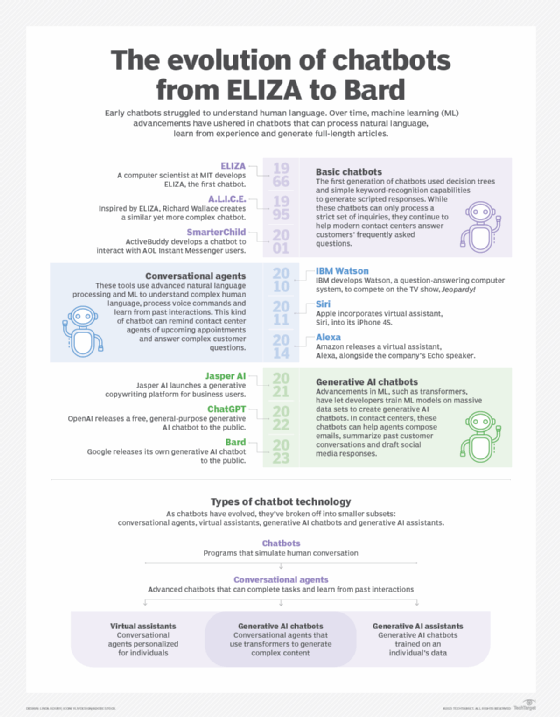The evolution of chatbots and generative AI
Customer service chatbots have evolved to include advanced NLP. The three evolutionary chatbot stages include basic chatbots, conversational agents and generative AI.

Customer service chatbots often struggle to understand natural language, which can frustrate users. But generative AI could make these chatbots smarter.
Humans have conversed with computers since the 1960s when Joseph Weizenbaum created ELIZA, the world's first chatbot. Early chatbot technology -- which many contact centers still use -- can respond to simple questions with scripted answers but lacks true intelligence. However, machine learning (ML) advancements in the 2010s have led to more advanced chatbots which can understand complex language, learn from past interactions and generate creative content.
Explore the three iterations of chatbots -- basic chatbots, conversational agents and generative AI chatbots -- and how they can enhance customer service.
Basic chatbots
The first generation of chatbots began in 1966 with Joseph Weizenbaum's ELIZA. Later examples include Artificial Linguistic Internet Computer Entity (A.L.I.C.E.) and SmarterChild. These basic or rule-based chatbots use algorithms to detect keywords in user inquiries and offer predetermined responses based on them. Because these chatbots lack advanced natural language processing (NLP) capabilities, human language often confuses them.
Many contact centers use these chatbots to help customers find answers to frequently asked questions. To avoid confusion, this technology can offer scripted input buttons to help guide users' inquiries. For example, a customer service bot might offer customers predefined options to select from, such as "Change password," "Order status" and "Store hours." The chatbot then provides scripted responses based on users' selections.
Conversational agents
Advancements in ML led to the rise of conversational agents in the early 2010s. Conversational agents use advanced NLP and ML capabilities to understand natural language more accurately than basic chatbots, and can learn from past interactions, understand voice commands and perform tasks. Conversational agents that serve individuals as opposed to teams, departments or companies are known as virtual assistants. Common examples include IBM Watson, Siri and Alexa.
Contact centers use conversational agents to help both employees and customers. For example, conversational AI in a pharmacy's interactive voice response system can let callers use voice commands to resolve problems and complete tasks. These systems can also detect customer sentiment and escalate calls to live agents if necessary. Additionally, some contact center software includes virtual assistants for agents that can offer real-time suggestions, schedule appointments and retrieve information.
Generative AI chatbots
In the late 2010s, advancements in ML -- such as transformer neural networks and large language models (LLMs) -- paved the way for generative AI chatbots, such as Jasper AI, ChatGPT and Bard. These ML advancements let developers train chatbots on massive data sets, which help them understand natural language better than previous conversational agents. Additionally, this advanced technology can generate creative texts, such as poems, song lyrics, short stories and essays, within seconds.
In contact centers, agents can use them to summarize past customer interactions and draft email responses. Additionally, these chatbots offer human-like interactions, which can personalize customer self-service.
The release of ChatGPT in 2022 sparked a wave of interest in generative AI from technology vendors, the general public and CX professionals. While simpler chatbots can handle basic customer service inquiries, generative AI chatbots could potentially help contact centers automate a greater percentage of customer service interactions.